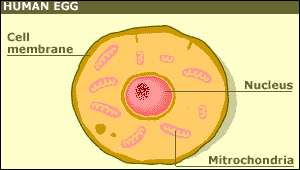T
Tom
Guest

UK scientists have won permission to clone a human embryo that will have genetic material from two mothers.
The Newcastle University team will transfer the nucleus of a human embryo made by one man and woman into an unfertilized egg from another woman.
The groundbreaking work aims to prevent mothers from passing certain genetic diseases on to their unborn babies.
Such diseases arise from DNA found outside the nucleus and thus inherited separately from DNA in the nucleus.
Mitochondrial diseases
The are collectively called mitochondrial diseases.
Mitochondria are small complex structures, which exist in every cell of the body, except red blood cells. They are the 'powerhouse' of the cell, producing most of the energy that we need to grow and live.
Those organs in the body that require a lot of energy to work properly, such as the brain, heart and kidney, are particularly dependent on well functioning mitochondria.
Diagram of human egg
One unique feature of mitochondria is that they have there own DNA, mitochondrial DNA, which is inherited from the mother only.
If this DNA is faulty, the mitochondrial diseases occur. At present no treatment for mitochondrial diseases exists.
Studies in mice show it is possible to prevent the transmission of mitochondrial disease by moving the nucleus from an egg containing bad mitochondria to another egg which only contains good mitochondria.
Professor Doug Turnbull, professor of neurology at Newcastle University, and Dr Mary Herbert, scientific director of Newcastle Fertility Centre at the city's Centre for Life, now plan to do the same in humans.
US scientists at the Institute for Reproductive Medicine and Science of St Barnabas, New Jersey, reported back in 2001 that they had successfully done similar, giving rise to 15 healthy children who appeared to be free of their mothers' disease.
Safety check
Instead of transplanting the nucleus, these researchers injected another woman's ooplasm- the substance inside the cell that contains the mitochondrial DNA and bathes the nucleus - into the egg cell of the mother with faulty mitochondrial DNA.
The innovative approach being tested may lead to a treatment for mitochondrial myopathies
Dr David Harrison of the Muscular Dystrophy Campaign
Their UK research, permitted by the Human Fertilisation and Embryology Authority and funded by the Muscular Dystrophy Campaign, will check that transplanting the nucleus works and is safe.
Although the resulting egg would never be allowed to develop into a baby, if it did the offspring would still resemble their mother and father because the mitochondrial DNA do not dictate things like hair colour.
About one in 5,000 children and adults are at risk of developing a mitochondrial disease.
The HFEA does not have any regard for public consultation and the views of the public
Josephine Quintavalle from Comment on Reproductive Ethics
The group of conditions Professor Turnbull's team will look at is called mitochondrial myopathy.
These cause muscle weakness and wasting, making it difficult for those who have it to move normally - some may need to use a wheelchair.
The Muscular Dystrophy Campaign said it was delighted that the HFEA had given approval for the research project.
Head of research Dr David Harrison said: "The innovative approach being tested by Professor Turnbull may lead to a treatment for mitochondrial myopathies, a group of conditions that dramatically affect quality and length of life."
The public are currently being consulted about their opinions on laws governing embryo research such as this.
Some believe it is dangerous and unethical to do human cloning work.
Josephine Quintavalle from Comment on Reproductive Ethics said: "This shows once again that the HFEA does not have any regard for public consultation and the views of the public."
http://news.bbc.co.uk/1/hi/health/4225564.stm
